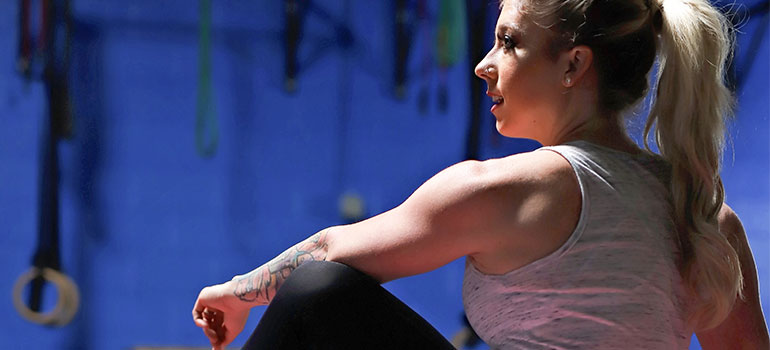After giving birth, many women experience Diastasis Recti, a condition where your belly sticks out because the space between your abdominal muscles has widened. The separation happens along the midline of the “six-pack” or rectus abdominis.
The condition is common and about two-thirds of pregnant women experience Diastasis Recti. It’s also not limited to women. Newborn babies and men also can experience it. Most men develop the condition from yo-yo dieting or doing sit-ups or weightlifting the wrong way.
What Is Diastasis Recti?
If you’ve heard of Diastasis Recti, you’re most likely thinking about those poor postpartum mamas fighting to button their pre-pregnancy pants around their now deflated and ever changed midsections. The condition itself is defined as a gap between the two sides of the rectus abdominal muscles (aka the 6-pack).
The condition can be diagnosed by a simple exam by your physician by palpation or ultrasound. You also can perform a post-baby self-check by lying on your back with your knees up and feet on the floor.
As you lift your shoulders off the floor, look down at your belly and use your hand to trace down the midline below your belly button.
The condition is measured in finger widths and if you can feel a gap of one or two fingers wide, it’s possible you have Diastasis Recti.
The good news is you don’t usually need surgery to repair it. The separation slowly will close as you regain your core strength. It’s best to know which Diastasis Recti exercises are safe for you to perform and which ones are not during the healing process.
If you have any concerns, it’s best to seek medical help to diagnose the condition and direct your treatment. Be proactive and seek the advice of a medical professional before beginning any Diastasis Recti exercise regime.
What’s the Best Way to Repair Diastasis Recti?
There’s almost always conflicting information on the internet when looking for best practices to fix Diastasis Recti. Sure, Google can be helpful, but it can sometimes be harmful too.
The top question: Can Diastasis Recti be fixed without surgery? The short answer is yes, but it’s best to seek sound advice of experienced professionals and get an opinion based on your unique body, condition, and circumstances.
I reached out to our own experts to find out how to fix Diastasis Recti. Since LadyBoss has an amazing team of coaches (seriously, they don’t even consider hiring a coach with less than 10 years of experience!) I had easy access to experts who not only knew about the condition but who had their own experiences with Diastasis Recti exercises postpartum.
LadyBoss Personal Results Coach Katie delivered twin boys in 2013 and ended up with an abdominal separation of more than four fingers width that lasted nearly a year. Because she had a background in pre- and postnatal fitness before her pregnancy, she knew about the risks. Coach Katie was able to heal her condition without surgery. She sought the advice of a Pelvic Floor Physical Therapist and took her part in the healing process and recovery seriously.
Women who give birth to multiple babies or who have more than one pregnancy with little time in between are more prone to experiencing Diastasis Recti. Women who have singletons, even ones spaced years apart, can still suffer from Diastasis Recti postpartum.
Coach Katie recommends new moms visit a pelvic floor physical therapist (sometimes called a women’s health physical therapist) to begin their recovery. Consulting an expert in this case, just like if you had a c-section, makes sense because no recovery is the same and exercises that help one woman repair Diastasis Recti may not work for someone else.
Recovery from Diastasis Recti is not a one size fits all approach, so it’s recommended that women are proactive about seeking out the advice of a professional to help them understand the condition before starting any Diastasis Recti workouts. Learning how to be aware of, and how to maintain, a healthy intra-abdominal pressure is key.
She encourages women to focus on deep breathing strategies to help manage intra-abdominal pressure. “We must learn how to connect the breath to the deep abdominal muscles and pelvic floor,” she says. “When you become aware of your breathing and pressure tendencies, you become aware of when your symptoms occur and you can begin to make adjustments to your breathing and movement strategies.”
To understand your breathing and pressure tendencies, a women’s health physical therapist can help you learn more. She will help you understand your own body, how to connect the breath and move safely while maintaining a healthy intra-abdominal pressure that promotes healing of the condition. With this knowledge, you can create individualized Diastasis Recti workouts.
 Symptoms and Complications
Symptoms and Complications
Chances are that if you’ve talked to a new mom wanting to “get her body back,” you’ll notice she’s trying to eliminate or shrink the bulge in her tummy area.
That “pooch” is one of the most common symptoms of Diastasis Recti. While most new moms focus on their appearance, Diastasis Recti also can cause lower back pain, poor posture, constipation and bloating.
Yes, you read that right. Bloating on top of the belly bulge? Thanks, Mother Nature.
Because Diastasis Recti causes abdominal weakness and pelvic floor instability, other problems can occur as well. Those problems include lower back pain, abdominal discomfort during activities like rolling over in bed or lifting heavy objects, and pelvic floor dysfunctions like urinary incontinence or pelvic organ prolapse.
Additionally, the weakened abdominal area creates visual changes in the appearance of the stomach resulting in drooping skin, continuing to “look pregnant,” or the all-to-well-known “pooch.”
You know what I’m talking about. That loose skin that just won’t tuck into the top of your pants enough for that smooth, flat look. Instead, you’ve got the “broken tube of biscuits” look. You’re working tirelessly, day after day, to tighten that area up so you can go out in public again without someone asking when you’re due, again.
Diastasis Recti Repair Exercises
Unfortunately, there is no magic, one-size-fits-all strategy for repairing Diastasis Recti. Although, a great reinforced pair of high-waisted leggings does a pretty good job of keeping it all in place. But those leggings only hide the unsightly, they don’t fix Diastasis Recti. To do that, it takes knowledge and work on your part.
To get the best, and safest exercises for your personal recovery, consult with a medical professional who can provide a full evaluation of your specific condition. A pelvic floor physical therapist also can offer feedback on how to safely and effectively perform the necessary exercises to meet your recovery needs. Consult your doctor, not Google.
Diastasis recti can be healed without surgery in many cases and it’s recommended that the recovery process should still be overseen by a medical health profession-ideally a Pelvic Floor Physical Therapist. It is best to understand your natural body tendencies and how to manage abdominal pressure before jumping right into Diastasis Recti workouts just willy-nilly. In the long run, it’s likely you will heal faster with less risk of pain and complications.
In general, there are some exercises to avoid because they can potentially worsen the condition. Once the condition is resolved you can slowly begin to add those exercises back into your routine.
Diastasis Recti Exercises to Avoid:
- Crunches
- Sit-ups
- Planks
- Upper body twisting exercises
- Double leg lifts
- Lifting and carrying heavy objects
- Other strenuous exercises and activities that cause your abdominal muscles to bulge out from excess abdominal pressure
Safe Diastasis Recti Exercises to Help Repair the Pelvic Floor:
- Kegels
- Bridges
- Practicing good posture
- Modified plank on hands and knees
- Arm and leg lift on all fours
- Standing balance work.
Some women find it difficult to target their pelvic floor muscles. Working with a pelvic floor physical therapist can help.
Getting Stronger
Although having Diastasis Recti can be frustrating, in most cases the condition can be repaired without surgery. While you’re working with your Pelvic Floor Physical Therapist, invest in a great pair of high-waisted leggings to keep you feeling confident and secure during the process. It took you 9 months to grow that beautiful baby, it’s going to take some time to get your body back. And from the moment of delivery of your firstborn, you are now, and ever will be considered postpartum.
Just remember, your postpartum pooch won’t last forever. Be gentle with yourself. Give yourself the gifts of grace, and time and self-acceptance to be where you are in your journey while healing from Diastasis Recti. You just need to give yourself the time to consult with professionals, eat a healthy diet, and do exercises that will help you rebuild your core strength.
So if you are willing to put in the time, seek out the professionals, and give yourself the time to recover-Diastasis Recti won’t be something you’ll be troubled with forever. That postpartum ab separation is only temporary. So, give yourself some time and love to let the healing happen. The pooch doesn’t have to last forever. Enlist the help of a skilled professional to help you identify your own personalized exercise program for strengthening your abdominal muscles and pelvic floor.
You can find great core-strengthening exercises on the LadyBoss® Pocket Personal Trainer.






















